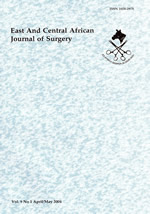
|
East and Central African Journal of Surgery
Association of Surgeons of East Africa and College of Surgeons of East Central and Southern Africa
ISSN: 1024-297X
EISSN: 1024-297X
Vol. 11, No. 2, 2006, pp. 15-20
|
 Bioline Code: js06029
Bioline Code: js06029
Full paper language: English
Document type: Research Article
Document available free of charge
|
|
|
East and Central African Journal of Surgery, Vol. 11, No. 2, 2006, pp. 15-20
| en |
Radionuclide Scan and Other Diagnostic Studies in Goitre Patients in Tanzania
E.T.M. Nyawawa, S. Yongolo, J. Tupa
Abstract
Background: Since the introduction of radioactive isotope scanning facilities in Tanzania, there has been no study to determine in the usefulness of this modality in evaluating the pattern of goiters. The aims of this study were to determine the pattern of radionuclide scan, its accuracy in diagnosing the nature of the lesion of a thyroid disease and comparing this with other available diagnostic techniques.
Methods: This was a retrospective study that evaluated 124 patients with goiters who underwent clinical evaluation, investigations and surgery for goiters at Muhimbili National hospital between June 2000 and July 2003.Patient's data were retrieved from theatre operation records and then from patient case notes for details, excluded were those whose investigations were incomplete. Data were entered into a questionnaire and later into an Epi info2000 program for analysis
Results: The male to female ratio was 1:6. The mean and median ages were 42.7 and 42.5 years respectively. The duration of the disease ranged from 1 to 20 years with a mean of 4 years. The overall incidence of malignancy was 18.6%. Both follicular and papillary carcinoma showed a parallel trend. The incidences of malignancy in "cold" and "warm" lesions were 35% and 3.6 % respectively. None of the "hot" lesions was malignant. The sensitivity for detecting malignancy by FNAC was 66.7% while the specificity was 92.5%. Serum levels T3/T4 and TSH were found to be appropriate to the radioisotope scan findings except in one patient who had raised T4 serum levels but had a "cold" lesion. The type of operation done and the indication as an overall management were appropriate.
Conclusions: The study showed that our patients had a high incidence of malignancy in "cold" thyroid lesions. There was low sensitivity for detecting malignancy by FNAC suggesting that in our setting, radioisotope thyroid scan might be the best preliminary investigation tool to give a presumptive diagnosis based on the uptake of the thyroid lesion before FNAC is undertaken.
|
| |
© Copyright 2006 - East and Central African Journal of Surgery
|
|
